Revisiting Portugal
The Moors, Cork, Pork, & the Chapel of Bones
Two Thousand Year Old Roman Ruins in Evora, Portugal, from the time of Augustus Caesar
 Lisbon's first streetcars were imported from San Francisco, and are called "Americanos" to this day.
Lisbon's first streetcars were imported from San Francisco, and are called "Americanos" to this day.
It is a great privilege and blessing to be able to visit Portugal twice within three months, first in December on a Viking River Cruise tour, and second in March on a Go Ahead Travels tour to Spain and Morocco commencing in Lisbon, Portugal. The Go Ahead company offered a tour of Lisbon similar to the one we had taken with Viking in December. However, on this tour day it was pouring rain, so we were not able to walk as extensively through the old city section of Lisbon, which dates from the Moorish ruled from the 8th to the 13th centuries.
We were also taken on a tour of the summer palace of the king dating back several hundred years. The furniture and artworks were amazing. However, the living conditions, and especially the primitive plumbing, reminded us that in the 21st century, the average Westerner lives better than the kings and queens of earlier centuries. 
Midievil Fortress Guarding the Entrance to Lisbon from the Atlantic Ocean
The centuries when Catholics acted like ISIS
Europe’s history is replete with stories of wars, conquests, invasions, occupations, and religious conflicts. Our excellent tour guide related more historical context than I can retell in this short blog. I will relate some of the stories that made the strongest impression on me.
1492 is the year Christopher Columbus discovered America. But that year also marked the year that Jews were expelled from Spain, followed in 1497 from Portugal. Spain and Portugal were united at this time through royal marriage.
The term “Moors” refers to that particular time of history when Islamic invaders from Africa occupied most the Iberian Peninsula (Portugal and Spain) in the eighth century. The word Moors comes from the Spanish word for “dark-skinned.” The word is not used for anyone in modern times. The word “Arabs” refers to the race, whereas the word “Moslem” refers to the religion. Not all Moslems are Arabs (e.g. Turks, Iranians, or Pakistanis). Not all Arabs are Moslems (e.g. the Chaldean Christians of Iraq and Arab Christians of Israel and Palestine).
This Moorish occupation of Iberia resulted in the introduction of amazing architectural construction, extravagant palaces and large mosques that were later converted into Catholic cathedrals. The Moors introduced the production of ornamental ceramic tiles, which continue to be a famous export of Spain and Portugal. The Moors introduced orange trees, which are planted in all the major cities as ornamental elements. Most of the ornamental orange trees are “bitter” oranges, much of which are exported to England to produce its famous orange marmalade. The Moorish influence remains to this day in many place-names beginning with the letters “al”, which is the article “the” in Arabic.
The Moors never conquered or occupied the northern Spanish state of Galicia, home of Santiago de Compostela, the pilgrimage destination I described in my December blog. (It is also the subject of the movie, The Way, which highlights this traditional Christian pilgrimage.) Galicia and other northern Christian states united in the thirteen century to re-conquer the Iberian Peninsula and expel the Moors. Two hundred years of religious co-existence followed, until 1492 when the dominant Catholic religion chose to act similar to today’s ISIS in Syria. Under the battle cry of “One People One Religion”, Moslems and Jews were forced to convert to Catholicism, leave the country, or be killed. This is the origin of the designation Sephardic Jews, which today refers mostly to Jews from Africa.
Jews who chose to convert to Catholicism, in order to remain, changed their names to disguise their Jewish identities. To this day, one sees pork loins hanging from the ceilings of butcher shops. This tradition highlights the tradition that Muslims and Jews are forbidden by their religions from eating pork. Thus, hanging a pork loin from one’s door was meant to deflect unwanted attention from the Inquisition, by indicating that by eating pork that they were loyal Catholics.
Would you like some pork with your expresso?
The Inquisition, present in both Spain and Portugal, was the religious court, which judged the purity of religious beliefs. Failing to pass the strict tests would likely result in torture and execution, by beheading, burning at the stake, or being “drawn and quartered” in which the condemned person’s body was pulled apart by horses attached to the four limbs.
We were told of a Spanish Jesuit priest who believed that an individual should be able to pray/speak to God directly, instead of going through the Latin-speaking Catholic hierarchy. This Jesuit priest was executed for his independent thought. Ultimately, religious fundamentalism, whether Catholic, Protestant, Jewish, Islamic, Hindu, or Buddhist, is all about controlling people, to keep them subservient to the dominant religious power brokers. This dynamic can be seen in every theocratic country, in which members of minority religions are oppressed and persecuted. This is why the founding fathers of the USA believed in the separation of church and state. This is why the potential for complete freedom of thought and religion is only possible in a secular state, no matter how benevolent the tenants of any particular religion might be in theory (and rarely in practice).
Spain was ruled as a proudly Catholic state by the dictator Francisco Franco (who allied himself with Hitler in WWII) until his death in 1975. Portugal was ruled in a similar fashion by its dictator, Salazar, until 1974. Only after their deaths did both countries become secular, offering complete freedom of religion. In fact, Spain was the first European country to legally recognize gay marriage. Abortion is also legal, which would not have been possible as long as it was a self-proclaimed Catholic country. Also to Spain’s credit, five hundred years after the expulsion of the Jews, Spain offers automatic Spanish citizenship to any Sephardic Jew who can prove to be a descendant of a family member that was expelled after 1492. (Israel is the only other country offering such automatic citizenship to immigrants who can prove their Jewishness.) Citizenship was not offered to Muslim descendants of the expelled Moors, because the Moors had originally come as conquerors, whereas the Jews were simply victims of religious oppression.
Purses made of highest quality cork
The relationship between cork and Iberian pork
Besides Port wine (named for the city of Porto), the main export of Portugal is cork. Cork is an amazing material, from the bark of the cork tree, that has been used for insulation on the space shuttle, among other high-tech applications. It was the French Benedictine monk, Dom Perignon, who discovered in the 17th century that cork provides the best method of sealing wine bottles.
Cork trees’ unique bark can be harvested beginning when the trees are only fifteen years old. The bark can only be harvested every nine years. However, the first harvest is irregular and thus not usable. So beginning when the tree is between twenty-five and thirty years old (at least nine years after the first harvest), a cork tree’s bark can be harvested regularly for the next three centuries. However, great care must be taken not to injure the tree in the process of removing the bark. Professional cork harvesters earn more than one hundred Euros/hour for their delicate work, which places them among the highest wage earners in Portugal.
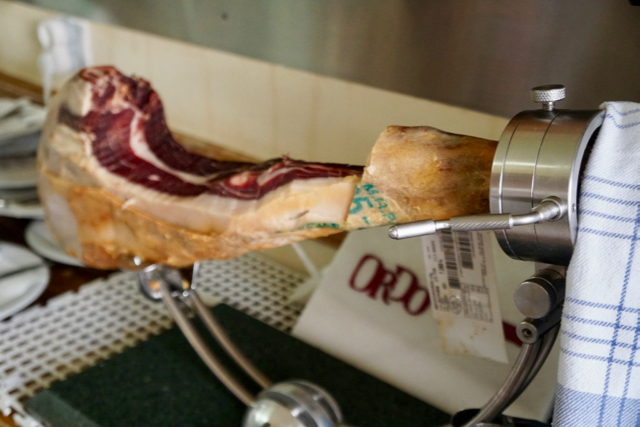 Iberian pork, served by cutting thin slices
Iberian pork, served by cutting thin slices
The cork trees also drop a distinctive seed, which is the sole food consumed by the special pigs which are raised to produce the famous Iberian pork. Just as Japanese Kobe beef is the most tasty and expensive beef in the world due to the care and controlled diet with which the cattle are produced, Iberian pork costs five times as much as regular pork, and is supposedly amazingly superior in taste and texture to normal pork. Iberian pigs are black (not pink) and are a cross between regular pigs and wild boars.
The corpse of one of the Evora chapel's founders, surrounded by his creation, the Chapel of Bones
Evora Portugal's Chapel of Bones
There is a tradition among European medical students, that when they graduate and become physicians, they each acquire a skull to be placed visibly in their offices, in order to remind them of their own mortality and the transitory nature of life.
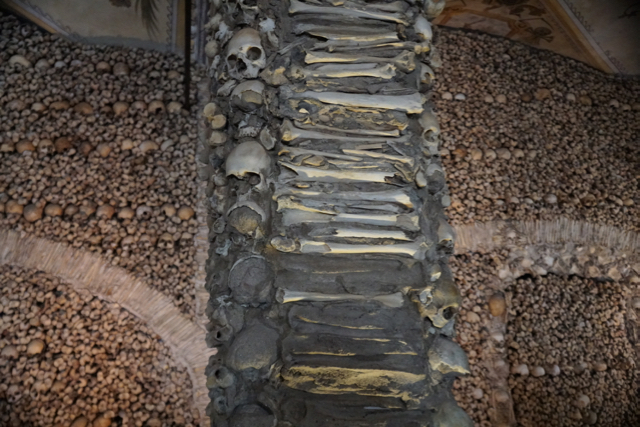 The monks of Evora, Portugal, have carried this tradition to its extreme. The result is an ossuary, a chapel constructed of thousands of human bones. The bones were collected from various old cemeteries around Evora, when the cemeteries were to be removed to make way for the city’s expansion. Rather than combine and re-bury the bones, the monks decided to build an ossuary in order to highlight the futility of materialism and to promote increased spiritual awareness in the face of human mortality.
The monks of Evora, Portugal, have carried this tradition to its extreme. The result is an ossuary, a chapel constructed of thousands of human bones. The bones were collected from various old cemeteries around Evora, when the cemeteries were to be removed to make way for the city’s expansion. Rather than combine and re-bury the bones, the monks decided to build an ossuary in order to highlight the futility of materialism and to promote increased spiritual awareness in the face of human mortality.
There is a very clear message above the entrance to the ossuary: “We bones are here, waiting for yours.” The walls are constructed from stacks of femurs. Skulls, minus their jawbones, are embedded for ornamentation. Smaller bones fill the spaces in between the larger ones. We were told that the chapel was used as a place of meditation and contemplation primarily for the monks who constructed it. We were told that similar ossuaries are found in Italy, Russia, and even in the Philippines. A similar intention is found in the catacombs (caves under the streets) of Rome and Paris, where bones were collected over many years from city graveyards as well as being used as a primary burial site for the monks over a period of several centuries.
 We observed a similar site in Cambodia, where there were large memorials filled with human skulls. But in Cambodia, these collections of bones are meant as a reminder of the brutality of the Khmer Rouge against their own people (who killed approximately five million Cambodians), as opposed to Catholic memorial ossuaries which call attention to the natural inevitable end to our short lives on earth.
We observed a similar site in Cambodia, where there were large memorials filled with human skulls. But in Cambodia, these collections of bones are meant as a reminder of the brutality of the Khmer Rouge against their own people (who killed approximately five million Cambodians), as opposed to Catholic memorial ossuaries which call attention to the natural inevitable end to our short lives on earth.
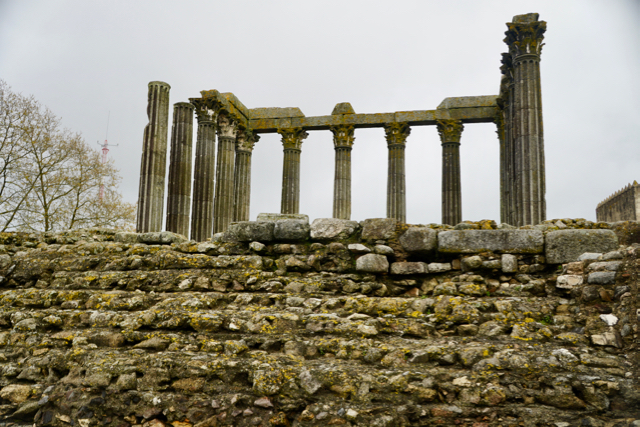
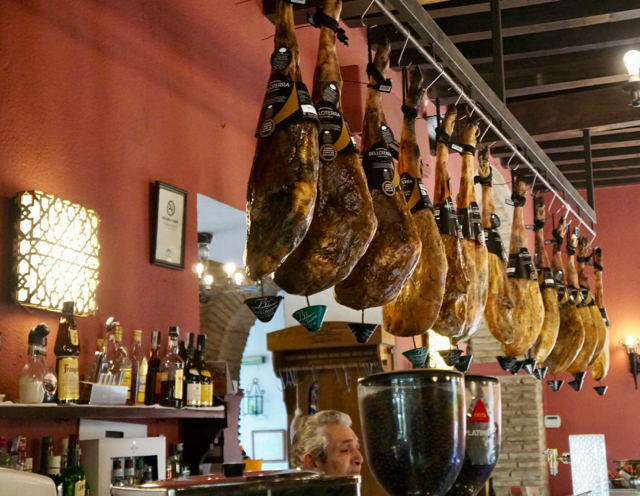
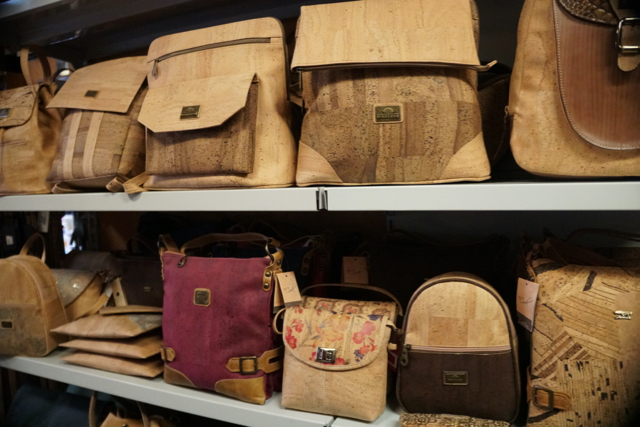

0 Comments on Revisiting Portugal
Join the Conversation